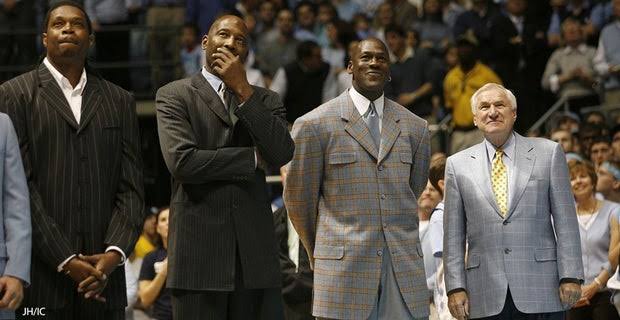The University of North Carolina has enjoyed decades of basketball excellence, from Frank McGuire’s unbeaten 1957 team to Roy Williams’ dominant runs in the 2000s. But if you ask most fans and historians, no season shines brighter than 1981–82. That was the year when Dean Smith finally captured his first national championship, James Worthy cemented himself as a legend, and a freshman named Michael Jordan hit the shot that would change basketball forever.
The Tar Heels entered the season loaded with talent. James Worthy, an explosive forward with unmatched athleticism, was their centerpiece. Sam Perkins, smooth and steady, provided the perfect inside-out balance. And then there was Michael Jordan—a freshman from Wilmington who arrived with hype but little national recognition. That was about to change in the most unforgettable way.
UNC powered through the season with a 32–2 overall record and a 12–2 mark in the ACC, proving themselves as one of the most complete teams in the country. Dean Smith, who had endured the label of a coach who “couldn’t win the big one,” finally had a roster that combined skill, toughness, and unshakable poise. Every game felt like a statement.
Fans packed Carmichael Auditorium that year, sensing history was in the making. UNC played beautiful basketball—fast when it needed to be, disciplined when it had to be. Worthy dominated the paint, Perkins stretched defenses, and Jordan slowly started to reveal the greatness that would make him a household name. For Tar Heel Nation, it was a dream lineup.
The NCAA Tournament that year became a stage for UNC’s coronation. After dispatching Alabama and Villanova, the Heels stormed into the Final Four in New Orleans. There, they took down Houston’s “Phi Slama Jama” squad led by Clyde Drexler and Akeem Olajuwon—a showdown that set up a championship game for the ages against John Thompson’s Georgetown Hoyas.
The 1982 championship game remains one of the most iconic in college basketball history. With Patrick Ewing patrolling the paint and Sleepy Floyd leading the backcourt, Georgetown looked like a powerhouse. But Carolina stayed calm. James Worthy was sensational all night, attacking relentlessly and keeping UNC in control.
Then came the defining moment. With under 20 seconds left and the score tight, the ball swung to the freshman—Michael Jordan. Calm beyond his years, Jordan rose up and buried a jumper from the left wing. It wasn’t just a basket; it was a moment that introduced “His Airness” to the world. Dean Smith, at long last, had his championship.
The game ended in dramatic fashion when Georgetown’s Fred Brown mistakenly passed the ball to Worthy in the closing seconds, sealing UNC’s 63–62 victory. For Tar Heel fans, it felt like destiny. For Dean Smith, it erased years of criticism. And for Michael Jordan, it was the first chapter in a career that would change the sport forever.
Worthy was named the Final Four’s Most Outstanding Player, but Jordan’s shot became the lasting image of the season. Perkins, steady as ever, was the glue. Together, they formed perhaps the most balanced trio in college basketball history. The 1981–82 Tar Heels weren’t just champions—they were artists, etching their names into the fabric of the game.
Looking back now, fans agree that season was the turning point for UNC basketball. It gave Dean Smith validation, cemented Carolina as a national powerhouse, and produced the single most famous jump shot in NCAA Tournament history. The blend of star power, history, and drama makes it hard to argue against 1981–82 as the greatest season in program history.
For Tar Heel Nation, the memory of that magical year is eternal. It was the season when a coach silenced the doubters, a team became immortal, and a young freshman named Jordan began his journey toward becoming the greatest player the game has ever seen. In Chapel Hill, 1982 isn’t just history—it’s a legacy.





























